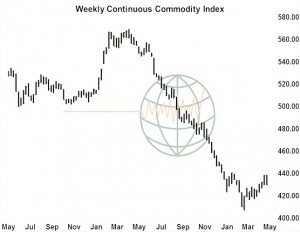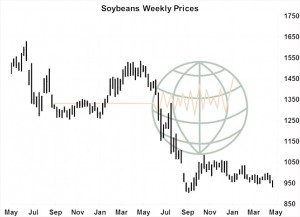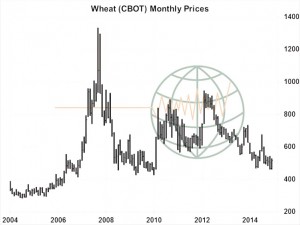Weekly CCI Analysis:
The CCI/CRB fell sharply on the week with the US$ rising following a 2 month correction. Ags, energy and metal markets all closed lower and seasonal price trends in the ags now point decidedly downwards. If the energy markets are unable to push to new highs in the week ahead, a test of the March CCI lows is expected by late July. US Fed Chairman Yellen indicated that the US Central Bank would raise interest rates by year end and that 1st quarter GDP weakness would not hinder US rate normalisation. If the US economy continues to gain traction, the US$/interest rates will both rise. Greece is still trying to negotiate a credit deal with the IMF and the EU Central Bank to avoid default. There are fears that Greece will have to default at some point amid building loan repayments. We maintain a bearish view on US and world commodity markets on oversupply and stagnant demand. A mid to late 2016 low is expected.

Longer-term soybean analysis:
Soybean futures broke out to the downside and finished the week lower with both old and new crop soybean futures marking new contract lows. Chinese demand for old crop S American and new crop US soybeans has clearly slowed, and basis in S America continues to work lower. China has clearly overbought on S American old crop beans with meal and crush margins both moving lower. Purchases of US new crop soybeans are off 53% from a year ago and are sitting at a six year low. Larger private estimates for S American production were also introduced to the market this week that suggest the USDA’s current estimates could be as much as 3-5 million mt too low. Our price models suggest that July soybeans could drop another $1/Bu ahead of expiration. With November to fall under $8.00 with good Central US weather.

Longer-term corn analysis:
Corn futures ended the week weaker following a lack of market-specific news. The Central US weather pattern is favourable, and of note, NOAA on Thursday projected cooler than normal temperatures and above average US rainfall into August – driven by El Niño. US crop conditions on Tuesday are expected to be at or above initial ratings in 2014 – and just below the record. The US corn market needs to stimulate export demand with domestic use stagnant. We have no problem with the USDA’s old crop forecast, as strikes in Argentina and rising fob premiums in Ukraine have made Gulf corn just competitive for export during June and July. However, steep discounts are noted in South America for August and beyond, and S American corn crops are getting bigger – most notably in Brazil where a record large harvest is possible. It’s early, but early US weather conditions have been favourable and the 2015 US corn yield is likely to exceed trend – it’s just a question of July weather and degree. We maintain that periodic short covering offers selling opportunities. Our downside price target for December corn is $3.00-3.20 with normal Midwest summer weather.

Longer-term wheat analysis:
Wheat futures rallied 8-15 cents on the week, led by higher protein contracts amid minor weather issues. Too much rain has fallen across TX, OK and S KS, warm/dry weather will impact Russia’s SE winter wheat crop, and longer term dryness is being watched in Canada. None of these is yet impacting world production or ending stocks just yet, but in the context of funds’ sizeable short position and minimal other news, the rally is understandable. Note that a wetter pattern is offered to Russia in the 8-15 day period, dry weather so far has triggered speedy planting in Canada, and quality issues in the S Plains will be only be determined at harvest. Note that Gulf SRW and HRW are not priced competitively, and the recent rally has only worsened the US’s position in the world export market. Another 10-20,000 contracts of fund shorts could be covered in the coming weeks, but lasting heat/dryness in Russia is needed to create a more bullish landscape. There’s no shortage of global wheat supplies in the near term. N Hemisphere harvest pressure will begin in mid/late June, and sub- $4.50 wheat is projected during mid to late summer months.


